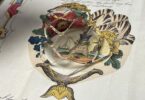Books and Ephemera on Death and Funeral Customs
Memento Mori
by Bohdan Chlibec; Mojmir Hornya; Vaclav Jirasek; Robert Novak; Ivan Pinkava
Stock Photo
1 copies starting at $ 100.00
The phrase and concept caught on with the growth of Christianity and spread throughout the world. There are chapels in Rome, Portugal, and the Czech Republic that have chandeliers, towers, sculpture and even walls made from or inlaid with hundreds of thousands of human bones. There are many ornate tombs covered in laughing skeletons and angels alike, artwork depicting the danse macabre – the dancing death – taking away poor and rich alike, and later on, complicated clocks and watches decorated with reminders that your final second is ever just around the bend.
The Victorian era was rife with dramatic funerary customs, many modeled after Queen Victoria’s intense and life-long mourning of her beloved husband, Prince Albert. It was common to clip locks of hair from the head of a deceased loved one to keep as a physical reminder of them. Some women even wove the hair into a fine mesh and made jewelry from it, or tucked it into lockets. Daguerreotypes and ambrotypes were growing more popular and many photographers specialized in post-mortem photography. Those pictures were then inserted into cards, lockets, or handmade frames crafted by the grieving women of the family who weren’t allowed to do much else during their restrictive mourning period.
We’ve found a few amazing historically significant Memento Mori broadsides spanning the centuries, as well as books, ephemera and some modern writings on the subject. Click through to see!
Historically Significant Memento Mori
 An Account of the Miller's Tomb, on Highdown Hill, near Worthing
Greenwich: Geo. E. Allen, .. Single sheet, 28 x 21 cm, printed on one side only. A little marked and creased, with cuttings from contemporary magazines pasted to the verso. A two column descri... More
An Account of the Miller's Tomb, on Highdown Hill, near Worthing
Greenwich: Geo. E. Allen, .. Single sheet, 28 x 21 cm, printed on one side only. A little marked and creased, with cuttings from contemporary magazines pasted to the verso. A two column descri... More$ 88.19
 Black and White May 28, 1910 *In Memoriam: The Royal Funeral of King Edward VII*
London: The Black & White Publishing Company Ltd., 1910. Magazine. Good. Paperback. First Edition. Folio - over 12" - 15" tall. Cover: In colour (mourning purple) Black & White In Me... More
Black and White May 28, 1910 *In Memoriam: The Royal Funeral of King Edward VII*
London: The Black & White Publishing Company Ltd., 1910. Magazine. Good. Paperback. First Edition. Folio - over 12" - 15" tall. Cover: In colour (mourning purple) Black & White In Me... More$ 299.95
 ONE PICTURE BOOK: POST MORTEM
Tucson, AZ: Nazraeli Press, 2005. First Edition. First Printing.. Hardcover. As New/No Dust Jacket, As Issued.. Tucson, AZ: Nazraeli Press, 2005. Hardcover. As New/None, As Issued. First Edition/Fir... More
ONE PICTURE BOOK: POST MORTEM
Tucson, AZ: Nazraeli Press, 2005. First Edition. First Printing.. Hardcover. As New/No Dust Jacket, As Issued.. Tucson, AZ: Nazraeli Press, 2005. Hardcover. As New/None, As Issued. First Edition/Fir... More$ 33.00
Funereal Customs, from Modern Art and Writing
The History of Death: Burial Customs and Funeral Rites, from the Ancient World to Modern Times
by Michael Kerrigan
Stock Photo
8 copies starting at $ 12.50
The Tibetan Book of Living and Dying The Spiritual Classic & International Bestseller; Revised and Updated Edition
by Sogyal Rinpoche; Patrick D. Gaffney; Andrew Harvey
Stock Photo
84 copies starting at $ 2.99
Grave matters journey through the modern funeral industry to a natural way of burial
by Mark Harris
Stock Photo
15 copies starting at $ 6.60
Before I say goodbye recollections and observations from one woman's final year
by Ruth Picardie
Stock Photo
19 copies starting at $ 4.49







